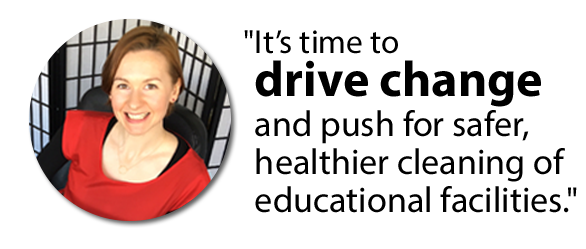The jury is in: Many of the cleaning chemicals found in schools across the country are a health hazard. Half of the 60 million+ students and staff who attend the nation’s schools daily are being exposed to polluted indoor air, caused in part by hazardous chemical fumes and pesticides. This causes real health challenges for our nation’s children. Children’s bodies are smaller and still developing-- that plus the additional time spent in school environments makes them especially susceptible to toxins and pollutants. It’s time to drive change and push for safer, healthier cleaning of educational facilities.
The Statistics Don’t Lie
Increasing evidence links exposure to common, traditional cleaning products with asthma. A study by the Environmental Working Group (EWG), an American non-profit environmental research organization, found that–
- 53 percent of cleaning products contain chemicals known to harm the lungs.
- 22 percent contain chemicals reported to cause asthma in otherwise healthy individuals.
- An evaluation of 21 common school cleaning products determined 29 percent emitted at least one of three common asthmagens into the air when used as directed. Those asthmagens are formaldehyde, methyl methacrylate and styrene, chemicals commonly found in air fresheners, perfumes and cleaners.
Statistics from the CDC (Centers for Disease Control and Prevention) and the EPA (US Environmental Protection Agency) show that asthma is a serious problem–
- Nearly 1 in 11 of children in the U.S. have asthma.
- Asthma is a leading cause of school absenteeism.
- Each year, 10.5 million school days are missed due to asthma.
Though there are many types of industrial chemicals that can cause asthma, those of greatest concern in cleaners include–
- Quaternary ammonium compounds (quats); added to antibacterial cleaning supplies and disinfecting air fresheners as germ killers.
- Ethanolamines (mono-, di- and triethanolamine); used to control product acidity (pH) and act as detergents in many classes of cleaning products.
- Bleach (sodium hypochlorite) and ammonia (ammonium hydroxide); possibly the most widely recognized cleaning ingredients in the world.
To those who still believe there aren’t enough harmful chemicals in traditional cleaners to contribute to the health challenges found to be common with children today, please take another look. With cleaning substances ranking the second most common cause of child poisonings in the US, the hazards are undeniable. According to the CDC, over 300 children per day are treated in the emergency room as a result of poisoning. Cleaning chemicals are not the only area of toxicity exposure, true, but they are a large part of the problem and one that can be lessened.
What Can We Do?
Simply being aware of the problem is the first step. Next, implementing a green cleaning program that reduces toxic fumes and improves indoor air quality is key. This doesn’t have to be expensive! Case studies† show that attendance rates increase and product and labor costs decrease with a properly implemented green cleaning program.
There are even small changes we can make to provide a safer, less toxic environment for students. Every action towards reducing children’s exposure to toxicity counts, no matter how small it may seem. Swapping traditional chemicals for green certified cleaners, being smart with disinfectants, reducing air freshener use or adopting an integrated pest management program can all help improve school environments one step at a time.

Many day cares, pre-schools, K-12s, universities and colleges have already taken steps to lead the charge in Green Cleaning Programs. However, despite the excellent and continued efforts of organizations like the Healthy Schools Campaign, Green Seal, EcoLogo, and the EPA, there is still much ground to be gained.
For employees of education facilities, a great place to start is the Healthy Schools Campaign, Green Clean Schools, 5 Steps to Green Cleaning.
For those selling cleaning chemicals, sell safer, healthier options and take accountability for the chemicals recommended to customers.
For manufacturers, make products that are safer and healthier by eliminating the ingredients known to harm people and the environment. It’s time to drive change in creating safer, healthier schools for children and staff alike.
†Implementing School Green Cleaning Programs:
https://www.greenbiz.com/research/report/2006/01/19/implementing-school-green-cleaning-programs
†The Real Costs of Institutional “Green” Cleaning
http://www.greenbusinessca.org/media/article_uploads/the_real_costs_of_green_cleaning_v6.pdf